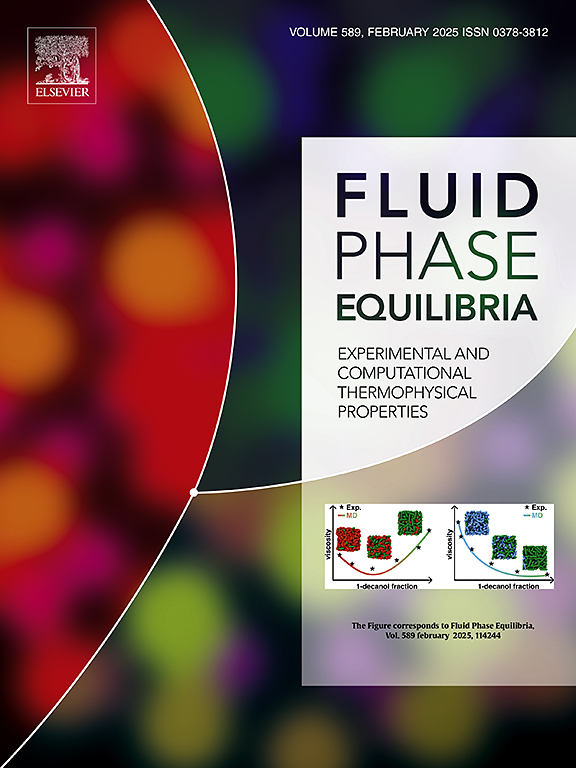粒度、水饱和度、无机盐和甲烷对沉积物中二氧化碳水合物相平衡的影响
IF 2.7
3区 工程技术
Q3 CHEMISTRY, PHYSICAL
引用次数: 0
摘要
了解气体水合物在复杂海洋地质环境中的热稳定性对基于水合物的碳封存具有重要意义。本研究在 273 至 283 K 的温度范围内定量测量了海洋沉积物(包括石英砂、无机盐和气体杂质)中影响 CO2 水合物平衡的因素,并建立了水合物相平衡模型。为了揭示孔隙结构的分布,利用低温扫描电镜测量了含水沉积物的微观形态。结果表明,降低初始水饱和度、添加 NaCl 和 CH4 对 CO2 水合物平衡有抑制作用。初始水饱和度通过毛细管压力降低了平衡温度,但当水饱和度降低到 5 % 时,仅观察到 0.3-0.7 K 的温度降低。加入 10 wt% 的 NaCl 和 24 mol% 的 CH4 后,发现平均温度降低了约 5.7 K。NaCl 和 CH4 通过改变水活度和水合物水晶格的化学势来影响水合物的平衡。扫描电子显微镜图像显示,在石英砂孔隙中形成的水合物具有多孔表面,并像一层直径为 5-20 μm 的细胞一样包覆在砂粒上,这表明水合物层存在于液相和气相之间。根据范德瓦耳斯-普拉蒂奥乌模型,建立了水合物平衡模型。该模型很好地预测了石英砂、NaCl 和 CH4 存在时的水合物平衡,平均偏差为 ±4.2 %,有望应用于更复杂的海洋沉积环境。本文章由计算机程序翻译,如有差异,请以英文原文为准。
Effect of particle size, water saturation, inorganic salt and methane on the phase equilibrium of CO2 hydrates in sediments
Understanding the thermal stability of gas hydrate in complex marine geological environment is of importance to hydrate-based carbon sequestration. In this work, the factors affecting the equilibrium of CO2 hydrate in ocean sediments, including quartz sands, inorganic salts and gas impurities were quantitatively measured in a temperature range from 273 to 283 K and a phase equilibrium model of hydrate was established. To reveal the distribution in pore structure, the micro-morphologies of hydrate-bearing sediments were measured by cryo-SEM. Results showed that reduction of initial water saturation, addition of NaCl and CH4 were found to have inhibitory effect on CO2 hydrate equilibrium. Initial water saturation reduced the equilibrium temperature by the capillary pressure, but only 0.3–0.7 K temperature depression was observed as the water saturation reduced to 5 %. About 5.7 K in the average temperature depression was found by the addition of 10 wt% NaCl and 24 mol% CH4. NaCl and CH4 influenced the hydrate equilibrium by changing the water activity and chemical potential of hydrate water lattice. SEM images showed that the hydrate formed in pores of quartz sand had porous surface and coated the sand particles like a layer of cells which are 5–20 μm in diameter, suggesting the hydrate layer exists between the liquid and gas phase. Based on the van der Waals-Platteeuw model, a hydrate equilibrium model was developed. The model provided a good prediction of the hydrate equilibrium in the presence of quartz sand, NaCl and CH4 with an averaged deviation of ±4.2 %, which had the potential to be applicated in more complexed ocean sedimentary environment.
求助全文
通过发布文献求助,成功后即可免费获取论文全文。
去求助
来源期刊

Fluid Phase Equilibria
工程技术-工程:化工
CiteScore
5.30
自引率
15.40%
发文量
223
审稿时长
53 days
期刊介绍:
Fluid Phase Equilibria publishes high-quality papers dealing with experimental, theoretical, and applied research related to equilibrium and transport properties of fluids, solids, and interfaces. Subjects of interest include physical/phase and chemical equilibria; equilibrium and nonequilibrium thermophysical properties; fundamental thermodynamic relations; and stability. The systems central to the journal include pure substances and mixtures of organic and inorganic materials, including polymers, biochemicals, and surfactants with sufficient characterization of composition and purity for the results to be reproduced. Alloys are of interest only when thermodynamic studies are included, purely material studies will not be considered. In all cases, authors are expected to provide physical or chemical interpretations of the results.
Experimental research can include measurements under all conditions of temperature, pressure, and composition, including critical and supercritical. Measurements are to be associated with systems and conditions of fundamental or applied interest, and may not be only a collection of routine data, such as physical property or solubility measurements at limited pressures and temperatures close to ambient, or surfactant studies focussed strictly on micellisation or micelle structure. Papers reporting common data must be accompanied by new physical insights and/or contemporary or new theory or techniques.
 求助内容:
求助内容: 应助结果提醒方式:
应助结果提醒方式:


